

Volkswagen Cars w/ Adaptive Cruise Control (All 11 Models)
Adaptive cruise control has been available mostly in luxury vehicles but is now common in many mainstream cars, including Volkswagens.
The Volkswagen cars, SUVs, and EVs in this post have adaptive cruise control or conventional cruise control system.
Check the corresponding tables to see the relevant model years when the system became available.

Adaptive Cruise Control vs. Cruise Control
The more-basic cruise control in older Volkswagen cars helps the vehicle maintain a steady cruising speed.
Adaptive cruise control (ACC) enhances the conventional cruise control system by adjusting the car’s speed to match the vehicle ahead, slowing or accelerating to the set speed when appropriate.
Newer Volkswagens have the IQ Drive technology that automatically maintains a set distance from the vehicle ahead, with the ability to brake on its own to avoid a potential collision.
Rival mainstream car makers that produce popular models with adaptive cruise control (ACC) include:
- Toyota vehicles with ACC .
- Kia vehicles with ACC .
- Honda vehicles with ACC .
- Hyundai vehicles with ACC .
- Nissan vehicles with ACC .
- Ford vehicles with ACC .
Volkswagen Cars with Adaptive Cruise Control
#1 volkswagen golf.
Although it’s no longer in production after 2021, the Golf hatchback remains a compelling purchase as a used car, with its excellent ride quality and versatile body – even the more-powerful Golf R is a competent daily driver .
All Volkswagen Golf models from 2003 to 2021 had standard cruise control that enabled a steady highway cruising speed.
Only in 2002 when the system first became available was cruise control not available at all trim levels.
#2 Volkswagen Polo
Although the VW Polo isn’t available on American shores, it’s a popular little car sold globally in Europe and many other countries.
Except for the latest generation that debuted in 2022, Volkwagen Polos from 2009 to 2021 had cruise control in the pricier variants, and all pre-2009 models only had the system as an optional add-on.
#3 Volkswagen Beetle
The discontinued Volkswagen Beetle had cruise control as a standard provision from 2012 to 2019.
#4 Volkswagen Jetta
In a class with all-stars like Honda Civic , Toyota Corolla , Hyundai Elantra , and Kia Forte – all with adaptive cruise control – the VW Jetta seems somewhat mediocre.
Still, from 2019 onwards, Volkswagen Jettas have had adaptive cruise control (ACC) in their higher trims and the more-basic cruise control in the lower ones.
Cruise control is standard across all Volkswagen Jettas from 2003 to 2018, with the 2001 and 2002 models only having the system in the more-expensive trims.
#5 Volkswagen Passat
2021 and 2022 Volkswagen Passat sedans have standard adaptive cruise control, while models from 2016 to 2020 only had the system in the higher trims.
Cruise control is standard across all Volkswagen Passat from 2001 to 2015, and older models before that period do not have the cruise management system.
2022 marks this midsize car’s final model year stateside.
#6 Volkswagen Arteon
This 2019 debutant is a unique large hatchback with sleek styling and sporty handling.
All Volkswagen Arteon models have at least the basic cruise control system, with the higher trims carrying the more-sophisticated adaptive cruise control (ACC) before ACC became standard from 2022 onwards.
Volkswagen SUVs with Adaptive Cruise Control
#7 volkswagen taos.
Since its introduction in 2022, the Volkswagen Taos subcompact SUV has had adaptive cruise control in the upper trims and cruise control in the lower ones.
#8 Volkswagen Tiguan
This model stands out among small SUVs with its three rows of seats.
Volkswagen Tiguans from 2018 onwards have had adaptive cruise control or cruise control, depending on the trim level.
All VW Tiguan models from 2009 to 2017 had standard cruise control.
#9 Volkswagen Atlas Cross Sport
This SUV is a two-row version of the VW Atlas.
Since its 2020 debut, the Volkswagen Atlas Cross Sport has had adaptive cruise control in the upper trims and conventional cruise control in the lower ones.
#10 Volkswagen Atlas
This SUV is a three-row midsize, seating up to seven.
Like the two-row variant, the Volkswagen Atlas with an extra row of seats has cruise control in the base trim and the more sophisticated adaptive cruise control in the costlier ones.
Volkswagen Electric Vehicle with Adaptive Cruise Control
#11 volkswagen id.4.
As the German marque’s pioneering electric SUV, Volkswagen ID.4 models have adaptive cruise control with lane centering across all trim levels.
References:
https://www.vw.com/en/models.html
https://www.vw.com/en/iq-drive.html

Home » Tips & Tricks » How to use Adaptive Cruise Control on VW Tiguan
How to use Adaptive Cruise Control on VW Tiguan
Adaptive Cruise Control on Volkswagen Tiguan helps maintain an individually stored constant speed between about 20 miles per hour and 95 miles per hour at a previously set distance in time intervals between your vehicle and those in front of you.
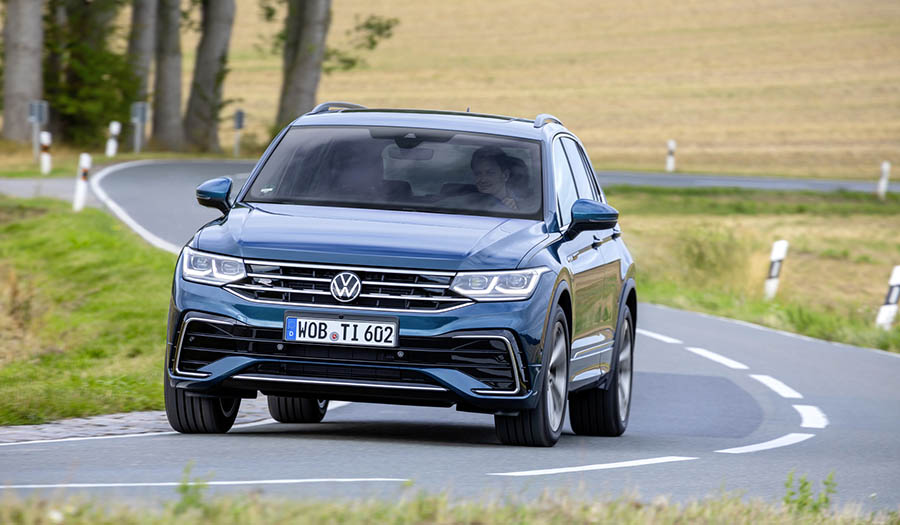
To switch on adaptive cruise control, press the on/off button on your steering wheel, the system is now active but no speed is set. To save the current speed when the vehicle is moving, press the SET button.
The set speed appears in the instrument cluster and the adaptive cruise control system begins regulating the speed to help automatically maintain a comfortable following distance to a vehicle in front.
Adjusting distance / gap
The adaptive cruise control system helps maintain the following distance by determining a time interval, resulting in a speed dependent distance. When adaptive cruise control is active, the following distance to the vehicle in front can be adjusted to one of five positions by pressing the adaptive distance button on the steering wheel.
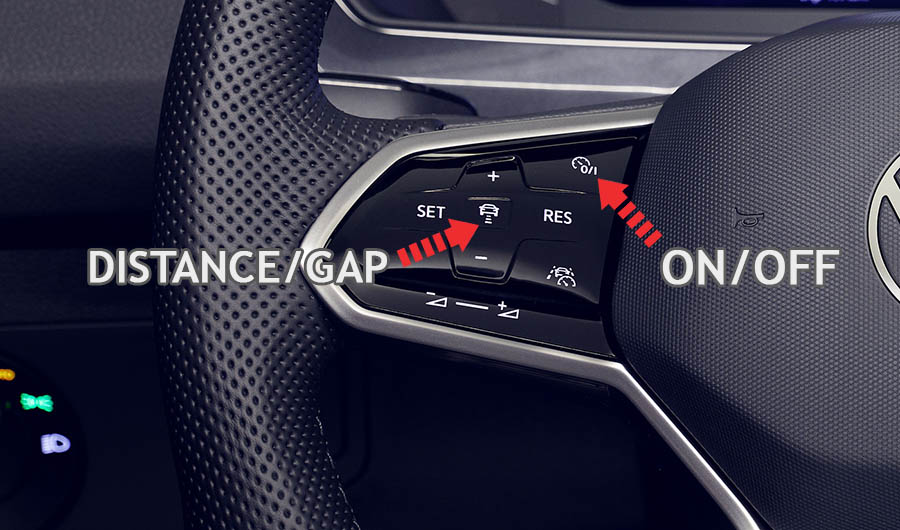
The distance intervals can also be set using the plus or minus buttons immediately after pressing the adaptive distance button.
When a slower moving vehicle directly ahead is detected, adaptive cruise control automatically slows down and helps maintain the distance that has been set. Once the slower vehicle moves out of the way, the system adjusts back to the set speed.
Stop and Go
If the vehicle traveling ahead brakes to a standstill, adaptive cruise control will also brake your vehicle to a standstill. The driver assist system holds your vehicle stationary with the brakes and adaptive cruise control staying active. To drive off after being stationary briefly, press the accelerator, adaptive cruise control will resume speed regulation as long as the vehicle in front is moving again.
Deactivate and resume ACC
To deactivate cruise briefly press the cruise on/off button on the steering wheel, or press the brake pedal. To resume the previously set speed, press the resume button RES .
To increase the speed by one mile per hour, briefly press the plus button or press and hold to increase the set speed in increments of five miles per hour. Press the minus button briefly to reduce speed by one mile per hour, or press and hold to reduce the set speed in increments of five miles per hour.
In addition to the functions of a traditional cruise control system, adaptive cruise control can help speed up or slow down your car to keep a comfortable following distance to the car ahead.

Good useful information.
Cruise control goes off when you turn off ignition is there a way to keep it on always? like older models?
- Oldsmobile Bravada AC blowing hot air – causes and how to fix it
- GMC Sierra 1500 horn not working – causes and how to fix it
- Skoda Kamiq window bounce back when closing – causes and how to fix it
- Volvo S90 key fob won’t lock or unlock the doors
- Ford Taurus engine overheating causes and how to fix it
- How to fold 2nd and 3rd row seats on Ford Transit Connect
- Kia Carnival Android Auto not working – causes and how to fix it
- Ford Crown Victoria bad mass air flow sensor (MAF) symptoms and causes
- Ford F-150 ABS light is on – causes and how to reset
- Buick Rendezvous bad alternator symptoms, how to check voltage
- Renault Koleos pulls to the right when driving
- Ford F-350 Super Duty pulls to the left when driving
- Chevy Cruze clogged catalytic converter symptoms, causes, and diagnosis
- Cadillac CT5 AC not blowing hard enough – weak airflow causes
- Apple CarPlay on Lexus UX250h, how to connect
- Audi A6 bad O2 sensor symptoms, causes, and diagnosis
- Cadillac XLR AC not blowing hard enough – weak airflow causes
- Jeep Grand Cherokee heater not working – causes and diagnosis
- Nissan Almera steering wheel controls not working – causes and how to fix it
- Apple CarPlay on Citroen C5 Aircross, how to connect
Ad-free. Influence-free. Powered by consumers.
The payment for your account couldn't be processed or you've canceled your account with us.
We don’t recognize that sign in. Your username maybe be your email address. Passwords are 6-20 characters with at least one number and letter.
We still don’t recognize that sign in. Retrieve your username. Reset your password.
Forgot your username or password ?
Don’t have an account?
- Account Settings
- My Benefits
- My Products
- Donate Donate
Save products you love, products you own and much more!
Other Membership Benefits:
Suggested Searches
- Become a Member
Car Ratings & Reviews
2024 Top Picks
Car Buying & Pricing
Which Car Brands Make the Best Vehicles?
Car Maintenance & Repair
Car Reliability Guide
Key Topics & News
Listen to the Talking Cars Podcast
Home & Garden
Bed & Bath
Top Picks From CR
Best Mattresses
Lawn & Garden
TOP PICKS FROM CR
Best Lawn Mowers and Tractors
Home Improvement
Home Improvement Essential
Best Wood Stains
Home Safety & Security
HOME SAFETY
Best DIY Home Security Systems
REPAIR OR REPLACE?
What to Do With a Broken Appliance
Small Appliances
Best Small Kitchen Appliances
Laundry & Cleaning
Best Washing Machines
Heating, Cooling & Air
Most Reliable Central Air-Conditioning Systems
Electronics
Home Entertainment
FIND YOUR NEW TV
Home Office
Cheapest Printers for Ink Costs
Smartphones & Wearables
BEST SMARTPHONES
Find the Right Phone for You
Digital Security & Privacy
MEMBER BENEFIT
CR Security Planner
Take Action
Guide to Adaptive Cruise Control
How this convenience feature works to reduce your stress on long drives
Adaptive cruise control (ACC) is like traditional cruise control, but smarter. ACC systems allow you to set a desired speed until your vehicle encounters slower-moving traffic. Then it will brake to maintain a set distance from the car ahead. Once the traffic starts moving again or if there is no longer a car in the lane ahead, ACC will accelerate to resume the previous set speed. Although ACC systems may take some getting used to, our survey respondents told us they appreciated the stress relief the feature brings.
“I use the feature mostly on the freeway and in stop-and-go traffic. I find it reduces tension and fatigue,” wrote a 2020 Subaru Outback owner. A 2018 Audi Q5 driver agreed. “It is so nice to just set it and let the car worry about the traffic,” they told CR.
The systems use lasers, radar, cameras, or a combination of those. If traffic slows to a stop, most ACC systems will bring the car to a complete stop, then bring it back up to speed when traffic gets going again. Others work only within certain speeds and/or might not start to accelerate automatically.
Adaptive cruise control (ACC): Cruise control that also assists with acceleration and/or braking to maintain a driver-selected gap to the vehicle in front. Some systems can come to a stop and continue while others cannot. If the car comes to a full stop, you may have to press the accelerator or a button on the steering wheel to start moving again.
Not all systems work at low speeds, so drivers who plan to use ACC in slow traffic should check the limitations of any system they plan to buy. These particular systems will often have the words “traffic jam” or “stop and go” in their name.
These features are usually activated using a button on the steering wheel with the image of a car next to a speedometer with an arrow pointing at it. A conventional cruise control system does not automatically keep a set distance away from the car in front, and it is indicated by a similar logo without the car next to the speedometer. A tip to know if your car has adaptive cruise control or regular cruise control is to look for the “gap distance” button, which usually shows a symbol of a car with horizontal distance bars in front. This button will determine how much space your car leaves between its front bumper and the rear of the car it is following.
In our most recent survey, we asked CR members to rate their experiences with the advanced safety and driver assistance systems on their model-year 2017 to 2022 cars. Respondents answered questions about their satisfaction with the systems. The survey covered about 47,000 vehicles. Most respondents told us they were “very satisfied” with ACC. Satisfaction was higher for older drivers.
OVERALL SATISFACTION
What to Look For in an Adaptive Cruise Control System
Every ACC system works slightly differently, says Kelly Funkhouser, manager for vehicle technology at CR. Some do a better job than others at recognizing merging traffic and automatically apply the brakes, while others wait too long to slow your car, requiring the driver to take control—especially when a vehicle in front of you cuts you off with a close merge.
“Most ACC systems can only be set to speeds above 20 mph but will slow the vehicle to speeds below that in stop-and-go traffic,” she says. “There are a few systems out there that don’t bring the car all the way to a stop but instead just shut off at low speeds. That can be dangerous when you’re traveling behind another slowing vehicle.” She recommends reading the automaker’s website closely and learning about the speed ranges before using ACC while on your test drive.
ACC is meant for convenience, not as a replacement for an alert driver, Funkhouser says. So don’t use adaptive cruise control as an excuse to get distracted. “Just because the car is controlling your speed doesn’t mean that you can check out,” she says. “These systems do not do well at detecting or slowing for vehicles ahead if you approach them at a high rate of speed. The driver should always be monitoring the surrounding traffic and looking ahead for potential hazards.”
Keith Barry
Keith Barry has been an auto reporter at Consumer Reports since 2018. He focuses on safety, technology, and the environmental impact of cars. Previously, he led home and appliance coverage at Reviewed; reported on cars for USA Today, Wired, and Car & Driver; and wrote for other publications as well. Keith earned a master’s degree in public health from Tufts University. Follow him on Twitter @itskeithbarry .
Sharing is Nice
We respect your privacy . All email addresses you provide will be used just for sending this story.
Trending in Car Safety
Best Cars of the Year: 10 Top Picks of 2024
Popular Cars to Avoid and What to Buy Instead
How to Escape Your Car If the Electronic Door Handle Fails
Safest New Cars of 2024, According to the IIHS
Travel Assist 1
Part of the iq.drive safety-enhancing and intelligent technologies.
The Travel Assist feature is a semi-automated driving assistant that blends the functions of Adaptive Cruise Control and Lane Keep Assist to help your Volkswagen maintain a safe distance from the vehicle ahead and keeps you centered in the lane.
Reduce driver workload and fatigue
Supports driver steering, braking, and accelerating
The Travel Assist feature in your Volkswagen combines Adaptive Cruise Control with Lane Assist to help maintain the vehicle 's position within the lane. When activated, it provides the driver with steering assistance , braking, and acceleration support.
This feature allows the vehicle to maintain a predetermined distance from the vehicle in front and stay centered in the lane within the system's limitations. It utilizes adaptive lane guidance to regulate the vehicle 's speed and steering, providing a comfortable driving experience .

Assists in emergency situations
Helps prevent collisions caused by driver inactivity or medical emergencies
When Travel or Lane Assist is active and something serious happens where you lose the ability to drive, Emergency Assist helps safely bring the vehicle to a stop and will contact assistance for you.
The ins and outs of travel assist
How it works
Designed to prevent fatigue on long highway trips, Travel Assist combines Adaptive Cruise Control and Lane Assist to help keep your vehicle centered in its lane, and maintain a preset distance from the vehicle ahead. Uses steering, braking and acceleration.
Instructions
- To activate, engage Adaptive Cruise Control and then switch to Travel Assist by pressing the ACC button on steering wheel. If Travel Assist is activated, a green indicator light will show in your digital cockpit.
- To set the speed, accelerate to the desired speed and press the SET button on the steering wheel.
- To deactivate, press the brake pedal.To resume, press the RES button on the steering wheel.
- To switch back to Adaptive Cruise Control, press the ACC button again on the steering wheel.
Limitations
- Both hands must be on the steering wheel.
- Braking force is limited. If additional emergency braking is needed, Front Assist may intervene.
- The following situations can disable the system:
- Damage to, misalignment of or blockage of the sensor.
- Towing heavy trailers or carrying heavy cargo in the rear of the vehicle , which can elevate the front of the vehicle and change sensor angles.
- To keep you centered in the lane, the vehicle must be able to detect clear road markings; if the markings are clear, the green indicator light in your digital cockpit will include green lanes.
- Designed to detect vehicles that are moving in the same direction of travel; does not react to oncoming or intersecting vehicles .
- System may not keep the vehicle in the lane in the following conditions:
- Poor weather conditions.
- Unclear lane markings.
- Driving below 35 miles per hour.
- Driving on a narrow curve.
- You must be driving above a minimum speed to activate the system. For some models the minimum speed is 15 mph; for others, it is 20 mph.
- Only reacts to objects within the sensor’s line of sight; some vehicles such as those depicted below are not detected until they are within the sensor’s line of sight.
- Once activated, system only operates between 0 and 95 mph.
- The following situations can lead to unwanted braking:
- Damage to or misalignment of the sensor or sensor mounting.
- Sensor blockage, which can be caused by ice/snow buildup, dirt, mud or leaves.
- Towing heavy trailers or carrying heavy cargo in the rear of the vehicle , which can elevate the front of the vehicle and change sensor angles.
- Curvature in the road.
Find answers about driver assistance
The VW Help Center
Discover answers to frequently asked questions about driver assistance features and general information about Volkswagen . Explore a wealth of information to better understand our products and services .

Ownership benefits
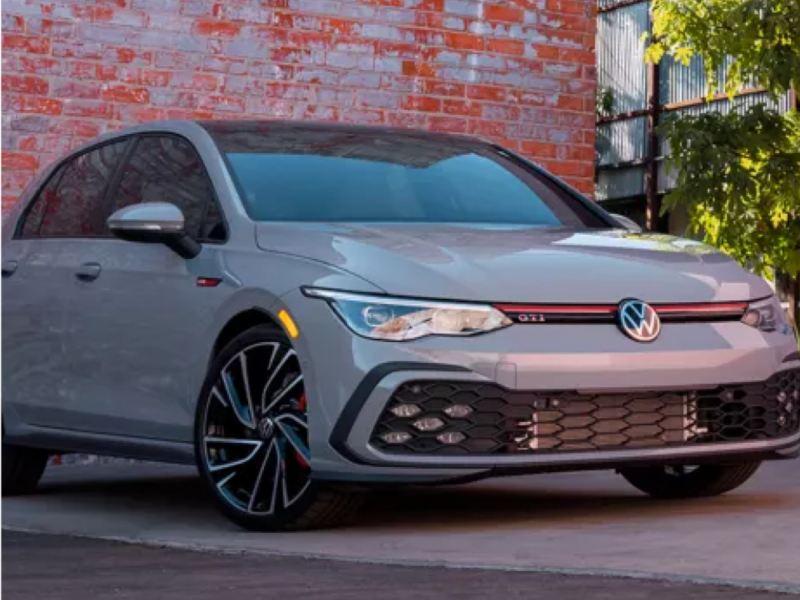
Shop Models

Build your ID.4
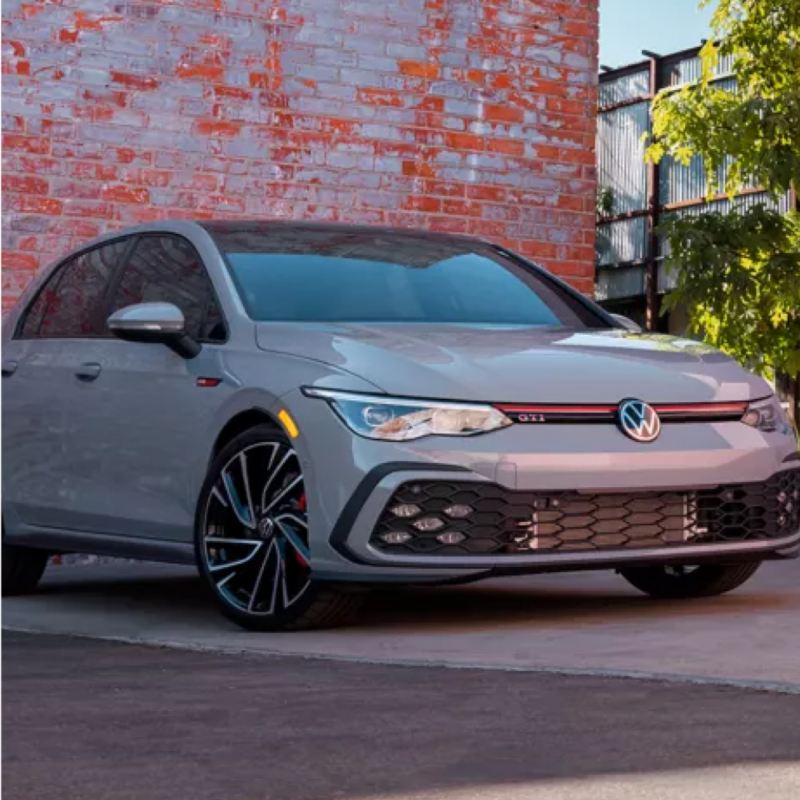
- What's My Car Worth?
- Buyer's Guide
What Is Adaptive Cruise Control?
Adaptive cruise control (ACC) is a system designed to help road vehicles maintain a safe following distance and stay within the speed limit. This system adjusts a car's speed automatically so drivers don't have to.

Adaptive cruise control (ACC) is a system designed to help vehicles maintain a safe following distance and stay within the speed limit. This system adjusts a car's speed automatically so drivers don't have to.
Adaptive cruise control is one of 20 terms used to describe its functions so that you might see adaptive cruise control as the following in advertisements and vehicle descriptions:
- Active cruise control
- Dynamic cruise control
- Radar cruise control
- Automatic cruise control
- Intelligent cruise control
ACC functions by sensory technology installed within vehicles such as cameras, lasers, and radar equipment, which creates an idea of how close one car is to another, or other objects on the roadway. For this reason, ACC is the basis for future car intelligence.
These sensory technologies allow the car to detect and warn the driver about potential forward collisions. When this happens, red lights begin to flash, and the phrase 'brake now!' appears on the dashboard to help the driver slow down. There might also be an audible warning.

Advantages of Adaptive Cruise Control
Limitations of adaptive cruise control.
Although there are many advantages to adaptive cruise control, there are still limitations to consider. One of the main faults in this system is the fact that it is not entirely autonomous. The driver of the vehicle still needs to practice safe driving habits that will work in tandem with this technology to produce the best results. Similarly, adverse weather conditions like snow, rain, or fog might confuse the system's sensors, as well as environmental factors such as driving through tunnels.
What Is the Difference Between a Level 1 Autonomous Car and a Level 2 Autonomous Car?
According to SAE International, when a car only has autonomous cruise control , it is considered to be a level 1 autonomous car. In contrast, a vehicle with autonomous cruise control and an additional feature, such as lane control, gets classified as a level 2 autonomous car.
How Much Does an Adaptive Cruise Control System Cost?
According to ExtremeTech, The cost of an adaptive cruise control system will vary depending on how many features you want. If you're going to have an ACC with all available features, you should be willing to pay anywhere between $2000 and $2500. If you are looking for minimal cruise control that would benefit speeds of up to 20-25 miles per hour, these more basic ACCs can cost as low as $500. The good news is that as ACC becomes more common, it will most likely reduce in price.
History of Adaptive Cruise Control
U.S. News says Mitsubishi first introduced adaptive cruise control in Japan in 1992 . This was a lidar-based distance detection system that detected objects that were getting too close. It was labeled as 'Debonair' and it was programmed to provide a warning to the driver about oncoming objects. The main difference was that it was the driver's job to apply the brakes and reduce their speed.
However, two years later in 1995, the Mitsubishi Diamante featured an upgraded approach to the Debonair called 'Preview Distance Control.' Unlike the original technology, this laser-powered system could adjust a driver's speed by downshifting or controlling the throttle. The driver was still responsible for applying the brakes.
From the early 2000s onward, big names in the car industry, such as Ford, BMW, Mercedes, Cadillac, Volkswagen, Infinity, Hyundai, Toyota, and Audi, created their versions of adaptive cruise control in their vehicles. These individual features have evolved into a high-tech system with automatic braking and speed control.
Types of Adaptive Cruise Control
Radar-based systems.
According to eInfoChips, radar-based systems work by placing radar-based sensors on or around plastic fascias to detect your vehicle's surroundings. Each radar sensor works together to create a comprehensive picture of the vehicle's proximity to other cars or potentially hazardous objects. This type of sensor can look different depending on the design and model of the car.
Laser-Based Systems
As mentioned by Electronic Design , this type of ACC system operates out of a large black box typically placed in the grille of your vehicle. It uses laser technology to detect the proximity of objects to your car. It does not operate well during rainstorms and other weather conditions.
Binocular Computer Vision Systems (Optical)
According to ExtremeTech, this is a relatively new ACC system put into use in 2013. It uses small cameras that are placed on the back of a vehicle's rearview mirror to detect front-facing objects.
Assisting Systems
Assisting systems are radar-based add-ons that customers can buy together. These pre-crash systems can offer lane control, brake assistance, cruise control, proximity alerts to objects like corners, and steering power.
Multi-Sensor Systems
According to Fierce Electronics , adaptive cruise control systems sometimes integrate more than one type of sensor to aid in a vehicle's operation. Multi-sensor systems incorporate several different sensor types to provide a driver with advanced information. These sensors might include GPS data equipment or cameras to gather information about a vehicle's geographic environment and proximity to other cars.
Predictive Systems
As mentioned by Autoblog, prediction systems are a type of ACC that uses sensory data to predict the actions of neighboring vehicles. This means that your car might slow down to brace for another vehicle suddenly switching lanes and, in doing so, promotes passenger safety.
Adaptive cruise control is evolving each year. Car companies are continuously making adjustments to this technology and, in doing so, creating more common and affordable options that can be purchased with a new car or added to older car models, making driving safer for everyday people.
Information and research in this article verified by ASE-certified Master Technician Keith Canete of YourMechanic.com . For any feedback or correction requests please contact us at [email protected] .
https://www.einfochips.com/blog/why-automotive-companies-should-adopt-radar-based-adas-systems/
https://www.electronicdesign.com/markets/automotive/article/21797633/adaptive-cruise-control-laser-diodes-as-an-alternative-to-millimeterwave-radars
https://www.autoblog.com/2015/01/14/new-honda-smart-cruise-control-predicts-other-motorists-future/
https://www.fierceelectronics.com/components/three-sensor-types-drive-autonomous-vehicles
https://www.extremetech.com/extreme/157172-what-is-adaptive-cruise-control-and-how-does-it-work
https://mycardoeswhat.org/safety-features/adaptive-cruise-control/
https://cars.usnews.com/cars-trucks/what-is-adaptive-cruise-control
https://www.caranddriver.com/features/columns/
https://www.sae.org/
.css-1updq97:before{background-color:#000000;color:#fff;left:0;width:50%;border:0 solid transparent;bottom:48%;height:0.125rem;content:'';position:absolute;z-index:-2000000;} Research .css-1e2ieb7:after{background-color:#000000;color:#fff;right:0;width:50%;border:0 solid transparent;bottom:48%;height:0.125rem;content:'';position:absolute;z-index:-2000000;}

Tundra vs. Tacoma: Comparing Toyota Pickup Trucks

Honda HR-V vs. CR-V: Examining the Differences
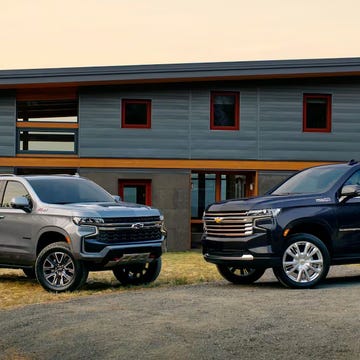
Chevy Tahoe vs. Suburban: Here Are the Differences
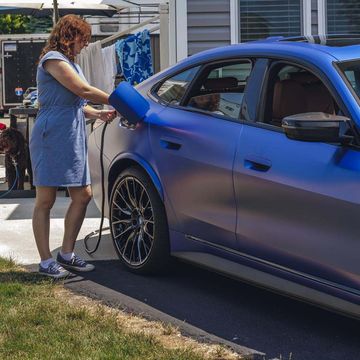
What Are the Different EV Charging Levels?
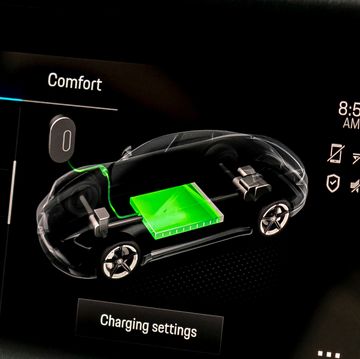
Electric Car Battery Life
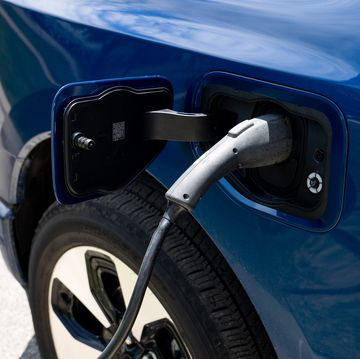
Electric Cars vs. Gas Cars: Pros and Cons

How to Clean Leather Car Seats
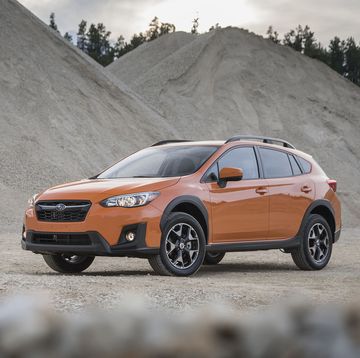
What to Buy: Subaru Crosstrek or Subaru Forester?

What to Buy: Jeep Cherokee or Jeep Grand Cherokee?
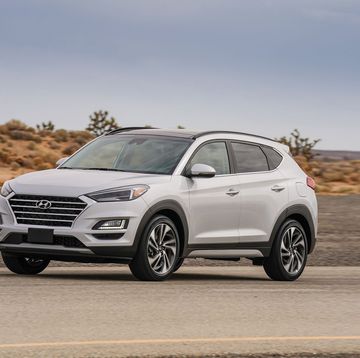
What to Buy: Hyundai Tucson or Hyundai Santa Fe?
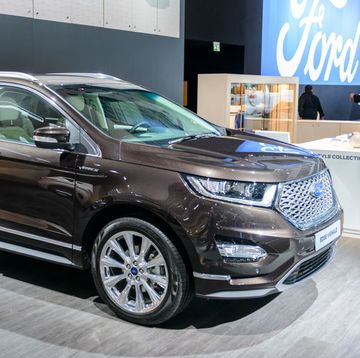
2019 and 2020 Ford Edge Colors
Driver Assistance Videos
Adaptive cruise control.
Adaptive Cruise Control (ACC) helps Volkswagen vehicles maintain a preset speed and distance from the car in front of you. When activated, if the car in front of you speeds up or slows down, the sensors can detect the change and your car follows suit.
Cruise control
Automatically keeps your car moving at a safe, constant speed..
Our cruise control system 1 works electronically to help regulate your car's speed. It reduces the stress on drivers and offers you more comfort on long journeys by keeping the vehicle at a constant speed. It's particularly effective when you have to stay within speed limits for a long way - when driving through miles of roadworks on the motorway, for example - and cuts the risk of your speed creeping up by accident.
The system works by memorising and maintaining the speed you select. It's very flexible, too. You can increase or reduce speed manually - to a defined value - and you also have the option of returning to the speed most recently memorised.
The cruise control system can be turned off simply by pressing a button or by pressing the brake or clutch pedals. For safety reasons, the cruise control system should not be used in heavy traffic or in difficult road conditions, such as heavy rain or ice.
For more information watch our cruise control video Opens an external link
Adaptive Cruise Control (ACC)
Volkswagen ’s safe distance technology ..
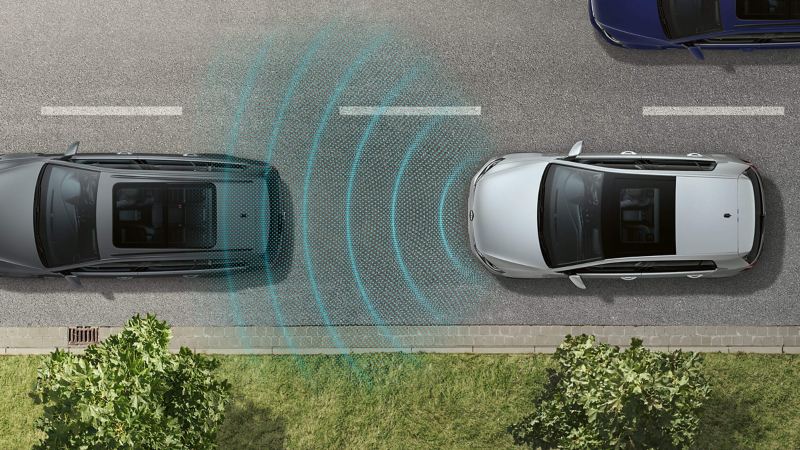
Adaptive Cruise Control (ACC) helps to avoid accidents by always keeping your car at a safe distance from the traffic ahead.
Working together with the radar-controlled Front Assist traffic monitoring system, our adaptive cruise control system keeps you at a safe distance from the vehicle in front, making driving much easier - whether on motor way journeys or in slow and moving traffic.
As with cruise control, you set the speed at which you want your car to maintain. This is then further enhanced by being equipped with the safe-distance technology using a radar sensor, which modulates your speed based on traffic conditions. The system detects traffic slowing ahead and automatically reduces your speed to match and maintain an appropriate gap to the car in front. If necessary, the system will bring your car to a complete stop.
It does this with the help of the Front Assist system which primes the brakes if it senses a collision is likely, shortening the stopping distance when the driver hits the brake pedal.
How it works
The safe-distance technology 's radar sensor has a range of up to 200 metres and a beam angle of 12 degrees. The radar sensor and control unit are combined into a single unit which is located at the front of the car.
Using the signals from the radar sensor, the control unit computes the distance to the vehicle ahead and your car's speed relative to it. It also works out its lateral position on multi-lane roads. If there are several vehicles within the sensor's field of coverage at the same time, this information is used to select which of the vehicles the system should track. The radar sensor is not capable of detecting stationary obstructions, such as the end of a tailback or crash barriers, however.
If approaching a slower vehicle ahead or if another vehicle cuts in front of you, the adaptive cruise control slows down the car by initiating corrective controls in the engine management and, if necessary, in the braking system too. If the required rate of deceleration exceeds 30% of the vehicle's maximum stopping power, visual and audible warning signals will prompt the driver to apply the brakes manually.
Adaptive Cruise Control V1.5
In addition to the standard Adaptive Cruise Control, this version has a greater operating range of speeds between 0 -130mph.
Adaptive Cruise Control with Predictive Cruise Control
In addition to the above, this updated version of ACC includes:
Road recognition - using information from front and rear cameras and route information, your vehicle will predictively adjust its speed prior to junctions and bends.
Speed Assist - using both the front camera and route information identifies changes in the posted speed limit and automatically adjusts the vehicles speed.
For more information watch our Adaptive Cruise Control video Opens an external link
Your protection is a priority for us, so we welcome independent crash tests to be carried out on our cars.
- Technology / Chassis & Transmissions
Adaptive chassis control DCC incl. driving profile selection
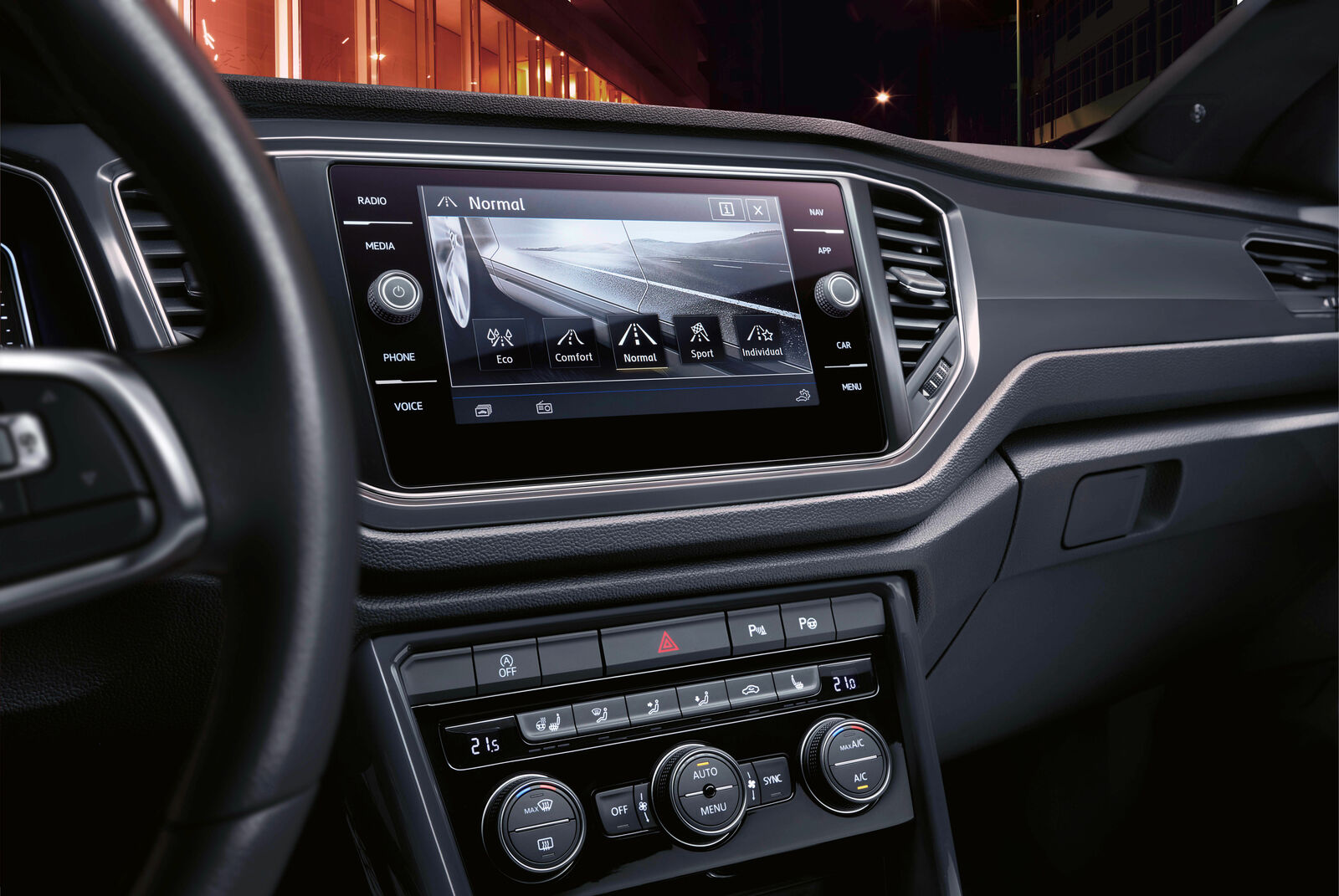
No matter whether you want sporty or more comfort-oriented handling, adaptive chassis control DCC offers you the option of adapting the running gear to your wishes. The electronically controlled shock absorbers react to road conditions and the driving situation in milliseconds and automatically adjust the damping characteristics. You can choose from a range of driving profiles such as Comfort, Sport or Normal.
Available in the following models
T-Roc T-Roc Cabriolet Touran Tiguan Tiguan Allspace
No matter whether you want sporty or more comfort-oriented handling, adaptive chassis control DCC offers you the option of adapting the running gear to your wishes. The electronically controlled shock absorbers react to road conditions and the driving situation in milliseconds and automatically adjust the damping characteristics. You can choose from a range of driving profiles such as Comfort, Sport or Individual. In the Individual profile, you can enter your own setting using a slider.
Passat Variant Arteon Arteon Shooting Brake
No matter whether you want sporty or more comfort-oriented handling, Adaptive chassis control DCC offers you the option of adapting the running gear to your wishes. The electronically controlled shock absorbers react to road conditions and the driving situation in milliseconds and automatically adjust the damping characteristics. You can choose from a variety of driving profiles such as Comfort, Sport or Individual. In the Individual profile, you can enter your own setting using a slider. The driving dynamics manager in the driving profile selection additionally improves handling and ensures greater driving pleasure and precision.
Golf Golf Variant ID.3 ID.4 ID.5
Press releases
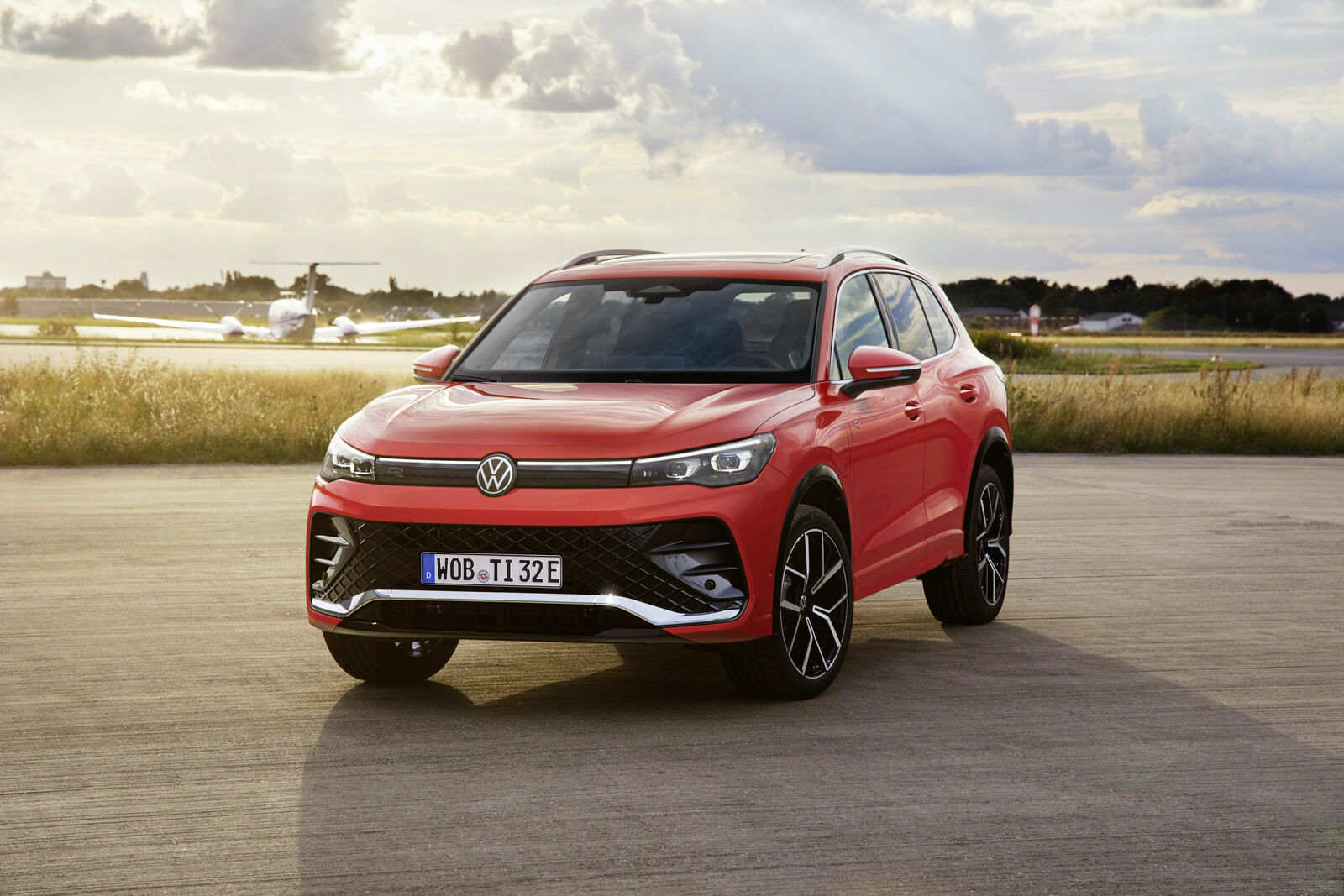
Volkswagen celebrates world premiere of the all-new Tiguan
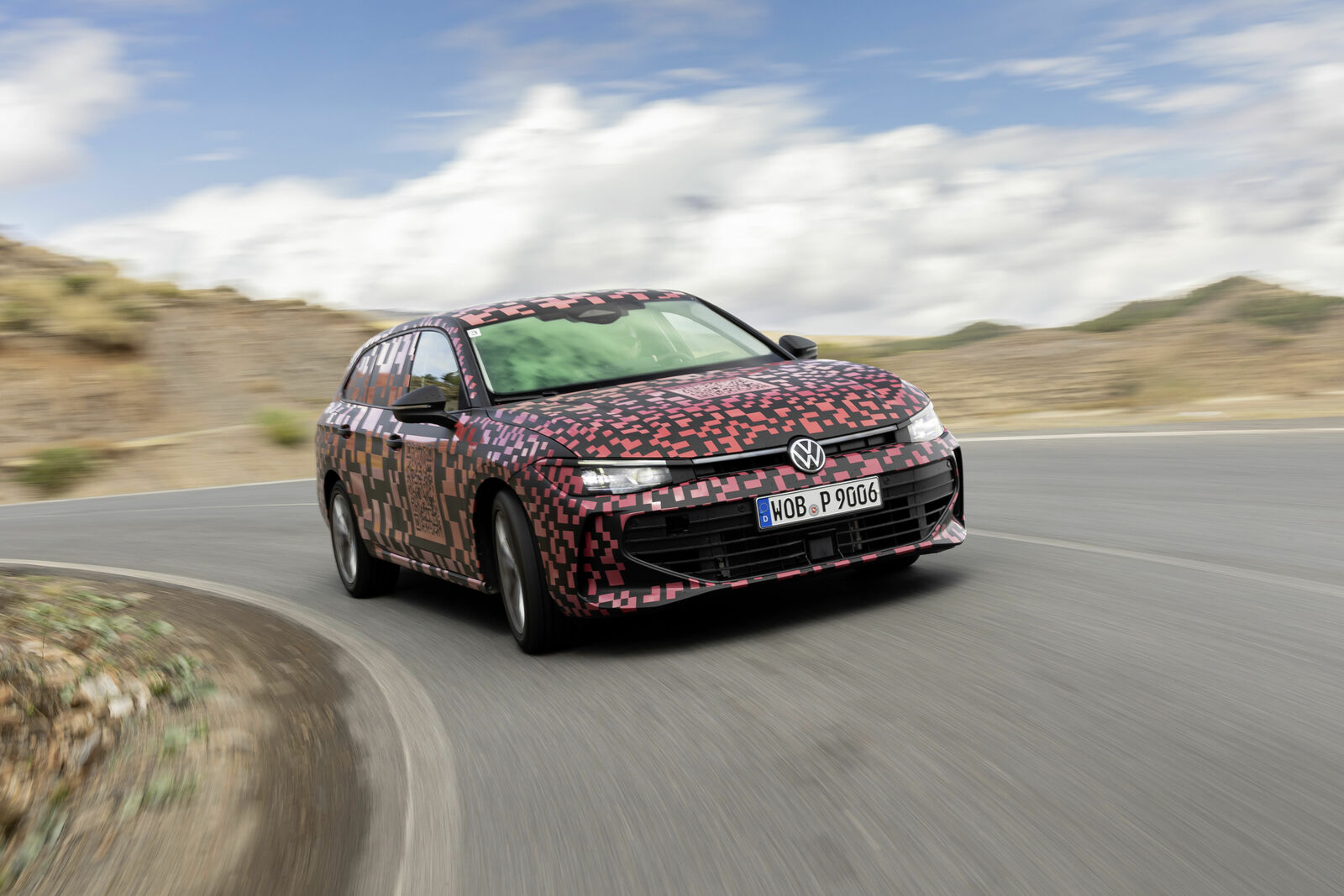
The all-new Passat Variant on final test drives
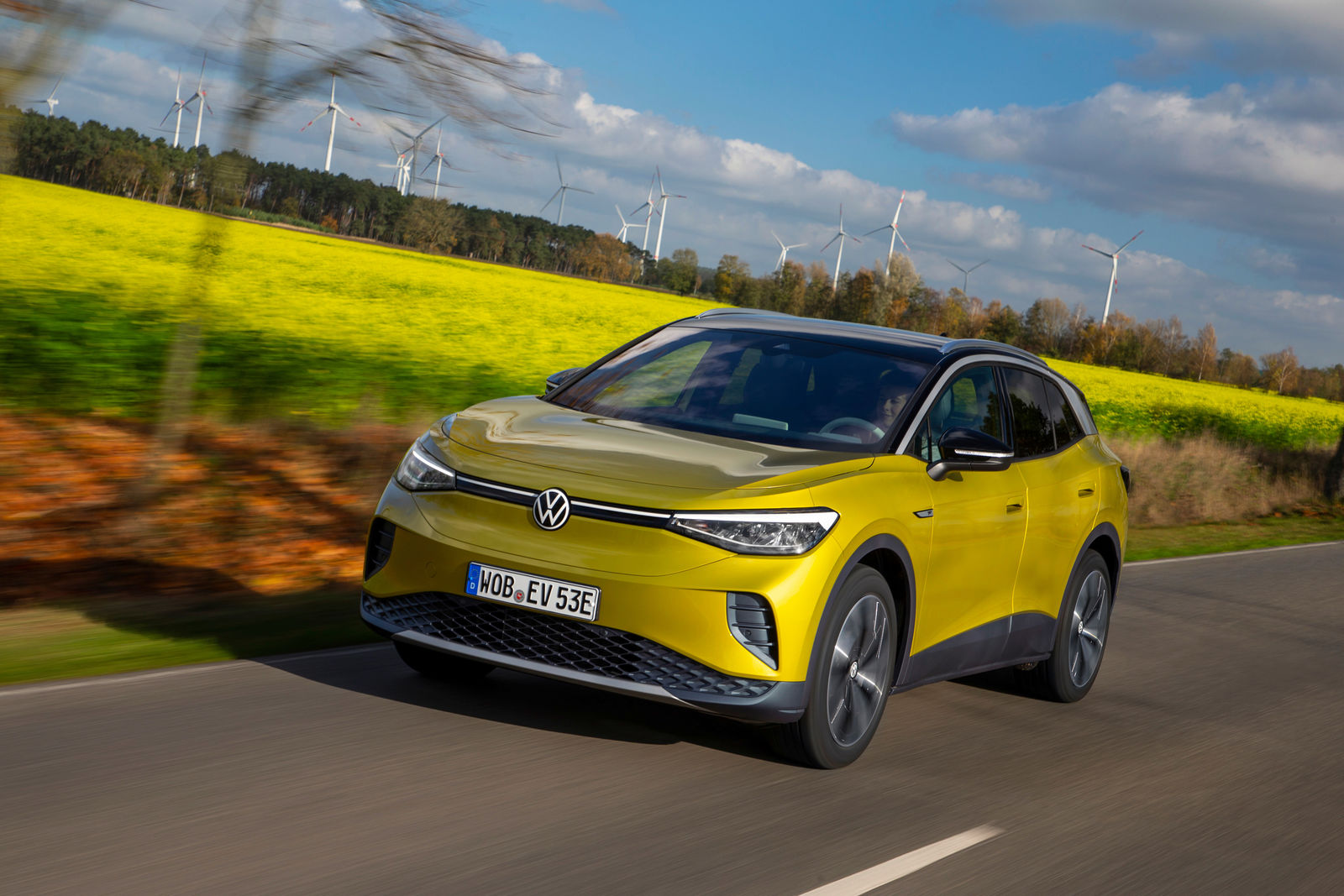
Well-balanced and sporty at the same time – the new ID.4 chassis
Basic infos.
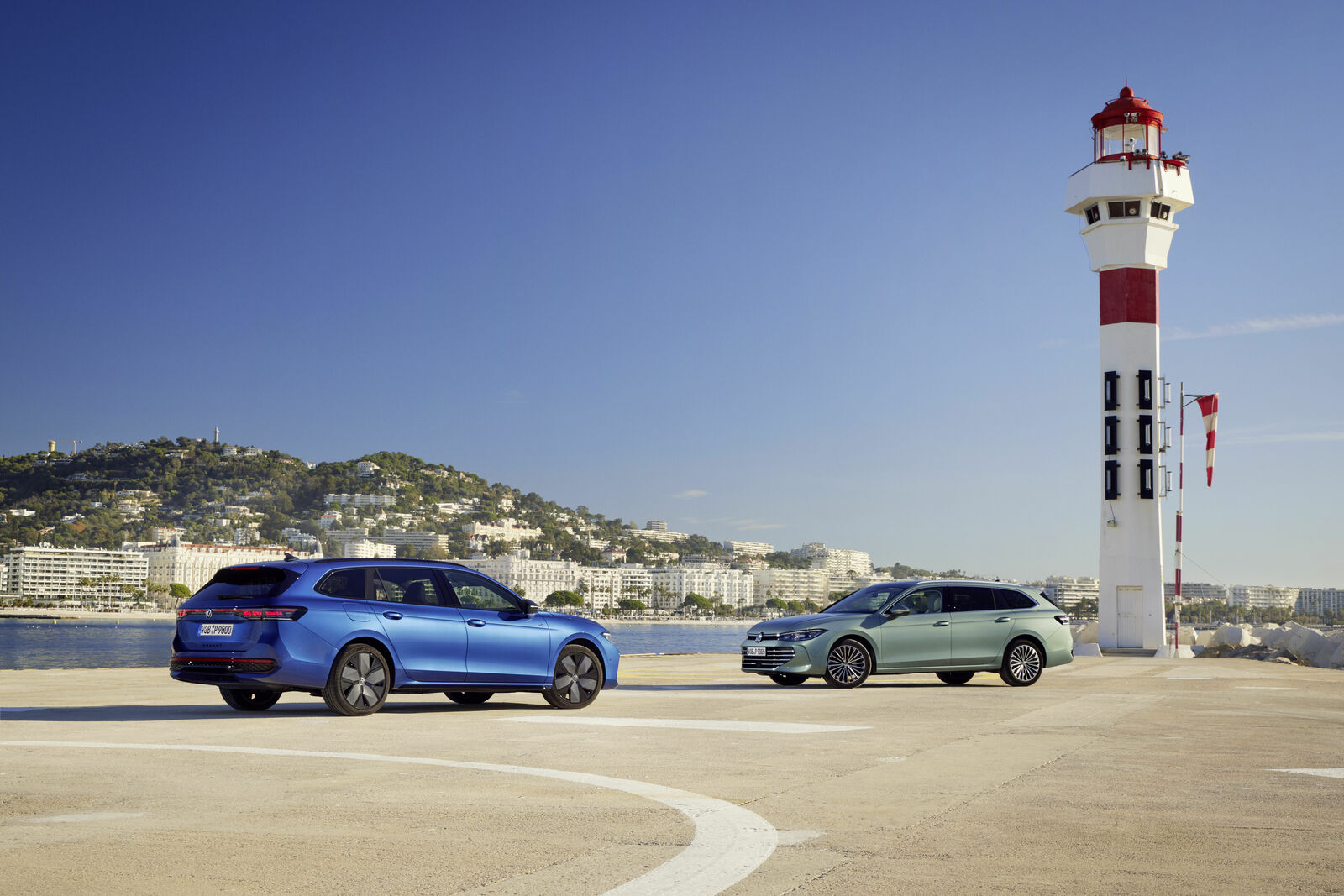
The new Passat - International Media Drive
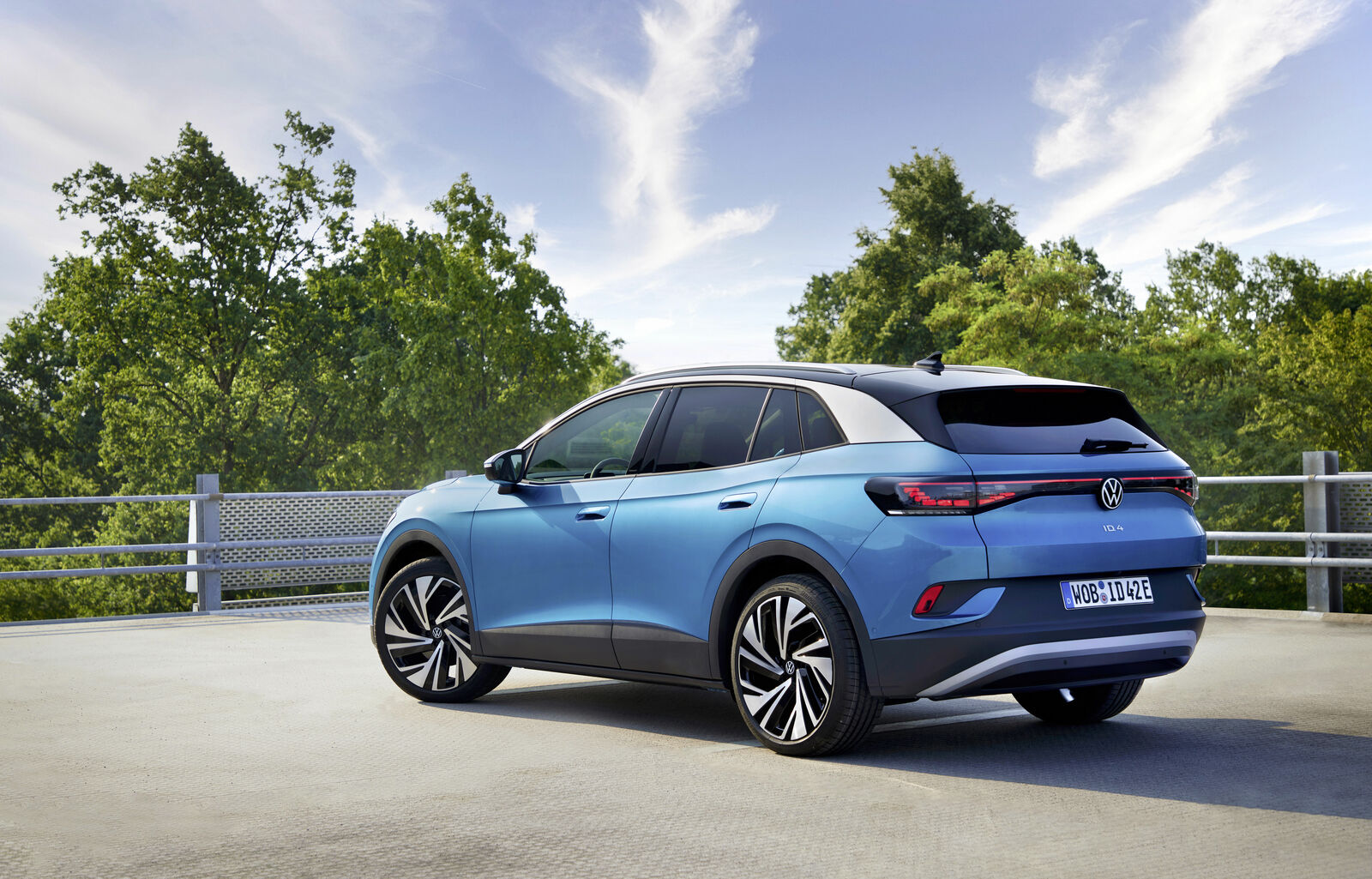
The new ID.4 and ID.5
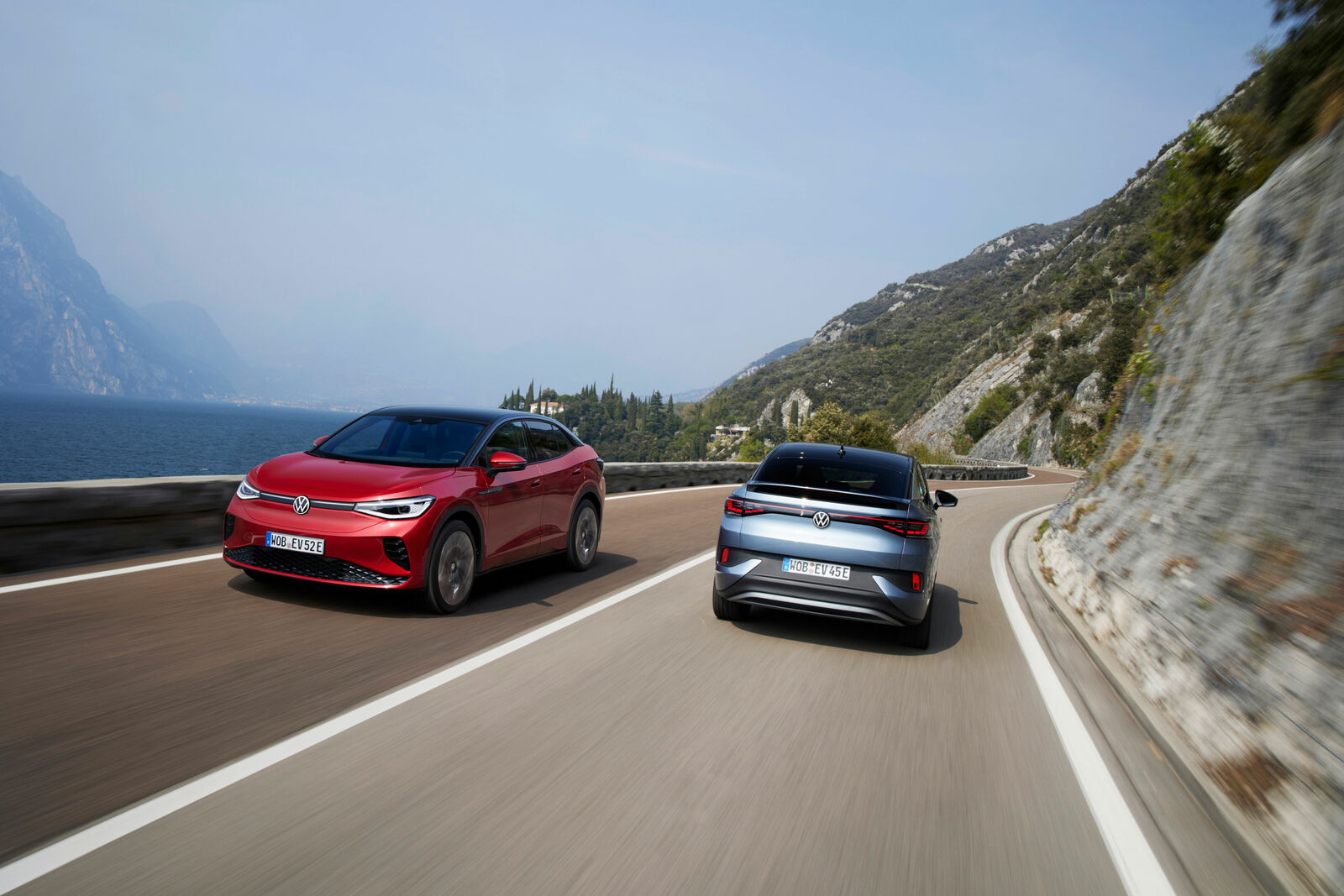
International vehicle presentation: Volkswagen ID.5 and ID.5 GTX
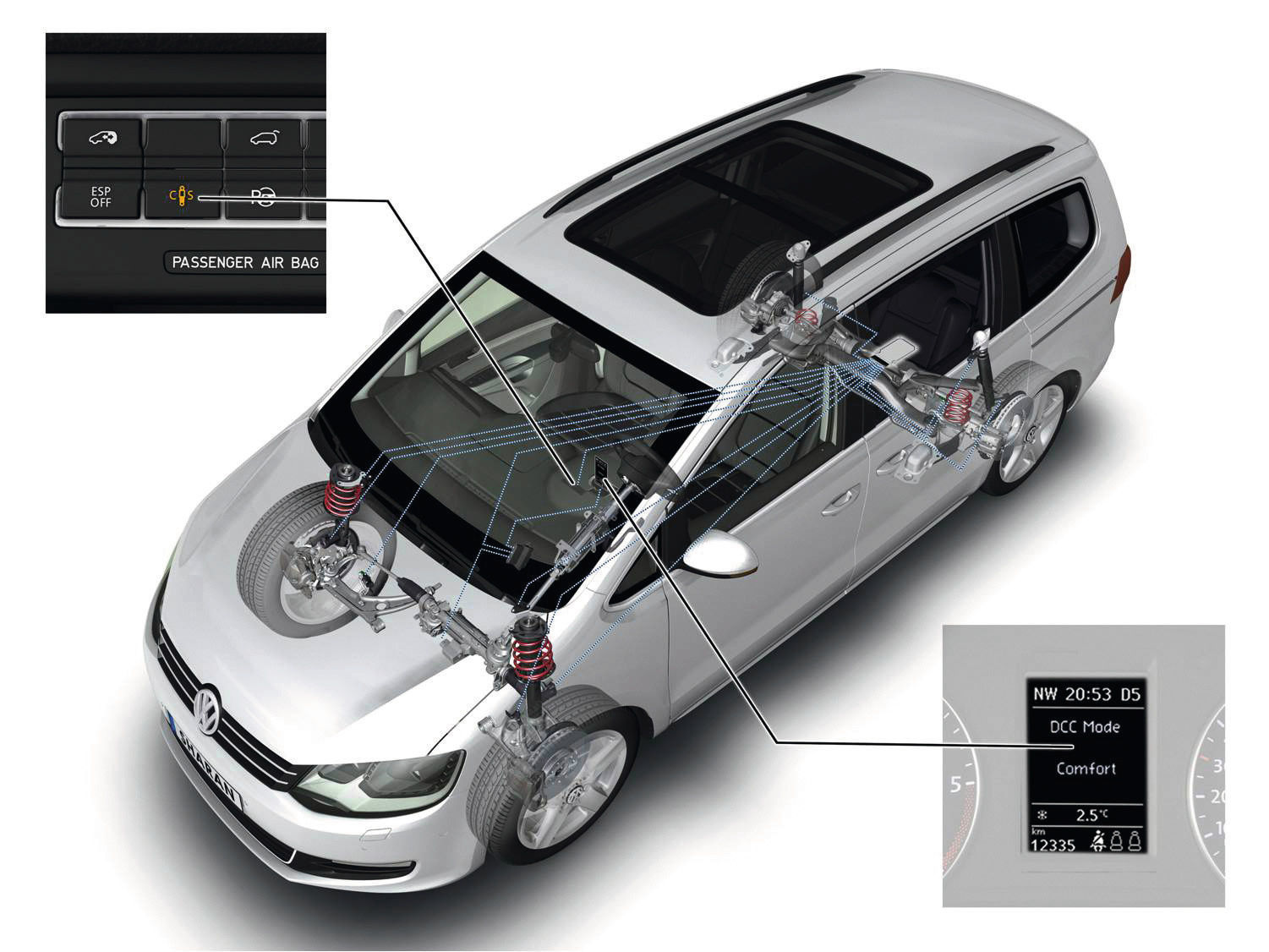
- Terms of Service
- Cookie Policy
- Third Party Licence Notes
- Volkswagen AG
- Cookie Settings
- Press Releases
- Basic Infos
- Media Documents
- Media Contacts
The Volkswagen Newsroom is an open platform and offers comprehensive search options to all users.
If you would like to be kept informed about our press releases you can also subscribe to our media information newsletter.
The specified fuel consumption and emission data are determined in accordance with the measurement procedures prescribed by law. 1 January 2022, the WLTP test cycle completely replaced the NEDC test cycle and therefore no NEDC values are available for new type approved vehicles after that date.
This information does not refer to a single vehicle and is not part of the offer but is only intended for comparison between different types of vehicles. Additional equipment and accessories (additional components, tyre formats, etc.) can alter relevant vehicle parameters such as weight, rolling resistance and aerodynamics, affecting the vehicle's fuel consumption, power consumption, CO 2 emissions and driving performance values in addition to weather and traffic conditions and individual driving behavior.
Due to more realistic testing conditions, fuel consumption and CO 2 emissions measured according to WLTP will in many cases be higher than the values measured according to NEDC. As a result, the taxation of vehicles may change accordingly as of 1 September 2018. For further information on the differences between WLTP and NEDC, please visit www.volkswagen.de/wltp .
Further information on official fuel consumption data and official specific CO 2 emissions for new passenger cars can be found in the "Guide to fuel economy, CO 2 emissions and power consumption for new passenger car models", which is available free of charge from all sales dealerships and from DAT Deutsche Automobil Treuhand GmbH, Hellmuth-Hirth-Str. 1, D-73760 Ostfildern, Germany and at www.dat.de/co2 .

Volkswagen Golf Owners Manual: Operating Adaptive Cruise Control (ACC)
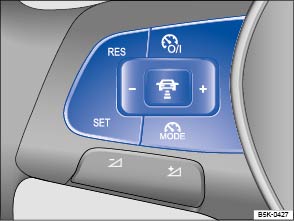
Fig. 169 Left-hand side of the multifunction steering wheel: buttons for operating the Adaptive Cruise Control (ACC)

Conditions for starting the Adaptive Cruise Control
- The selector lever must be in position D or S or be in the Tiptronic gate. A forward gear, but not 1st gear, must be selected in the manual gearbox.
- In vehicles with a manual gearbox, the actual speed should be minimum 30 km/h (18 mph) if no speed is stored.
Controlling speed
When switched on, the speed can be stored and set. The stored speed can vary from the speed actually being driven if the distance is being actively controlled.
The mph figures given in brackets in the table relate exclusively to instrument clusters with mile readings.
Stop-and-go traffic and the vehicle automatically pulling away

Automatic pulling away is not available for all vehicles and countries.
Setting the distance level
The speed-dependent distance from the vehicle in front can be set to one of 5 levels in the infotainment system .
In wet road conditions, you should always set a larger distance than when driving in dry road conditions.
The following distances can be pre-selected:

When the highest level is reached, the distance returns to the lowest level when the button is pressed again.

Setting the driving programme
In vehicles with Driving Mode Selection, the selected driving mode (Driving Mode Selection) can affect the acceleration response .
The following driving modes can be selected:
The following conditions can prevent the Adaptive Cruise Control (ACC) from reacting:
- If the accelerator is depressed.
- If no gear is selected.
- If the ESC is taking corrective action.
- If the driver has not fastened seat belt.
- If there is a fault in several brake lights on the vehicle or on a trailer with an electrical connection to the vehicle.
- If the vehicle is reversing.
- If the vehicle is travelling faster than approximately 160 km/h (100 mph).

- The ACC may not be able to recognise all driving situations correctly.
- Leaving your foot on the accelerator will mean that the ACC will not brake automatically. This is because manual acceleration overrides the system.
- You should always be prepared to brake the vehicle yourself.
- Observe country-specific regulations regarding the minimum distance.

The set speed will be deleted if the ignition or the ACC is switched off.
The ACC is automatically deactivated when the traction control system (TCS) is deactivated.
In vehicles with a start/stop system, the engine is switched off automatically during the stationary phase of ACC and is then restarted for moving off.
Radar sensor
Switch off the adaptive cruise control (acc) temporarily in the following situations, other materials:.
Removing and installing trailer detector control unit -J345- Note When renewing the control unit, select Renew function for the respective control unit in Guided fault finding or Guided functions mode → Vehicle diagnostic tester. Removing � ...
Removing and installing automatic anti-dazzle interior mirror, with rain and light sensor -G397- and front camera for driver assist systems -R242- Removing – Unclip front cover -1- from front interior light -W1- and pull it downwards by approx. 10 mm -arrows A-. – Release locking lugs -3- using as small screwdriver. ...
Mounting front seat on seat repair stand Special tools and workshop equipment required Torque wrench -V.A.G 1331 Torque wrench -V.A.G 1783 ...
- Sustainability
- Commodity grades
- OMCARB lines
- Application
Quality control
Product safety.
- Health protection and ecology
- Head office
- Production sites
- Logistics centers and offices
Sustainable development
The company’s sustainable development policy aims at continual improvement and keeping the balance between production needs, social responsibility and environmental protection.
Omsk Carbon Group priorities:
Health care and environmental protection.

- Custom test
This is the simple version of the problem. The only difference between the simple and hard versions is that in this version $$$u = 1$$$.
As is known, Omsk is the capital of Berland. Like any capital, Omsk has a well-developed metro system. The Omsk metro consists of a certain number of stations connected by tunnels, and between any two stations there is exactly one path that passes through each of the tunnels no more than once. In other words, the metro is a tree.
To develop the metro and attract residents, the following system is used in Omsk. Each station has its own weight $$$x \in \{-1, 1\}$$$. If the station has a weight of $$$-1$$$, then when the station is visited by an Omsk resident, a fee of $$$1$$$ burle is charged. If the weight of the station is $$$1$$$, then the Omsk resident is rewarded with $$$1$$$ burle.
Omsk Metro currently has only one station with number $$$1$$$ and weight $$$x = 1$$$. Every day, one of the following events occurs:
- A new station with weight $$$x$$$ is added to the station with number $$$v_i$$$, and it is assigned a number that is one greater than the number of existing stations.
- Alex, who lives in Omsk, wonders: is there a subsegment$$$\dagger$$$ (possibly empty) of the path between vertices $$$u$$$ and $$$v$$$ such that, by traveling along it, exactly $$$k$$$ burles can be earned (if $$$k < 0$$$, this means that $$$k$$$ burles will have to be spent on travel). In other words, Alex is interested in whether there is such a subsegment of the path that the sum of the weights of the vertices in it is equal to $$$k$$$. Note that the subsegment can be empty, and then the sum is equal to $$$0$$$.
You are a friend of Alex, so your task is to answer Alex's questions.
$$$\dagger$$$Subsegment — continuous sequence of elements.
The first line contains a single number $$$t$$$ ($$$1 \leq t \leq 10^4$$$) — the number of test cases.
The first line of each test case contains the number $$$n$$$ ($$$1 \leq n \leq 2 \cdot 10^5$$$) — the number of events.
Then there are $$$n$$$ lines describing the events. In the $$$i$$$-th line, one of the following options is possible:
- First comes the symbol "+" (without quotes), then two numbers $$$v_i$$$ and $$$x_i$$$ ($$$x_i \in \{-1, 1\}$$$, it is also guaranteed that the vertex with number $$$v_i$$$ exists). In this case, a new station with weight $$$x_i$$$ is added to the station with number $$$v_i$$$.
- First comes the symbol "?" (without quotes), and then three numbers $$$u_i$$$, $$$v_i$$$, and $$$k_i$$$ ($$$-n \le k_i \le n$$$). It is guaranteed that the vertices with numbers $$$u_i$$$ and $$$v_i$$$ exist. In this case, it is necessary to determine whether there is a subsegment (possibly empty) of the path between stations $$$u_i$$$ and $$$v_i$$$ with a sum of weights exactly equal to $$$k_i$$$. In this version of the task, it is guaranteed that $$$u_i = 1$$$.
It is guaranteed that the sum of $$$n$$$ over all test cases does not exceed $$$2 \cdot 10^5$$$.
For each of Alex's questions, output "Yes" (without quotes) if the subsegment described in the condition exists, otherwise output "No" (without quotes).
You can output the answer in any case (for example, the strings " yEs ", " yes ", " Yes " and " YES " will be recognized as a positive answer).
Explanation of the first sample.
The answer to the second question is "Yes" , because there is a path $$$1$$$.
In the fourth question, we can choose the $$$1$$$ path again.
In the fifth query, the answer is "Yes" , since there is a path $$$1-3$$$.
In the sixth query, we can choose an empty path because the sum of the weights on it is $$$0$$$.
It is not difficult to show that there are no paths satisfying the first and third queries.


IMAGES
VIDEO
COMMENTS
Adaptive cruise control (ACC) helps drivers maintain a constant speed and distance from the vehicle ahead using sensors to detect other vehicles. The system can reduce speed of the vehicle if there is a slower moving vehicle ahead, bring the vehicle to a standstill, and resume speed regulation as long as the vehicle in front is moving again.
#4 Volkswagen Jetta. In a class with all-stars like Honda Civic, Toyota Corolla, Hyundai Elantra, and Kia Forte - all with adaptive cruise control - the VW Jetta seems somewhat mediocre.. Still, from 2019 onwards, Volkswagen Jettas have had adaptive cruise control (ACC) in their higher trims and the more-basic cruise control in the lower ones.
Models. Adaptive Cruise Control ACC helps you to maintain a previously set maximum speed and a predefined distance to the vehicle ahead 03. It also features predictive cruise control and cornering assist function. ACC can adapt the vehicle speed to the applicable speed restrictions and course of the road (bends, roundabouts, etc 0304.
2021 Volkswagen Tiguan, second generation facelift - (photo by VW) To switch on adaptive cruise control, press the on/off button on your steering wheel, the system is now active but no speed is set. To save the current speed when the vehicle is moving, press the SET button. The set speed appears in the instrument cluster and the adaptive ...
Have you ever wondered what the ACC function in your VW is for? Let´s learn more about using the adaptive cruise control and how it can make your driving exp...
A POV How-To Video that shows how to use Adaptive Cruise Control on a VW.How to use Adaptive Cruise Control Volkswagen AtlasHow to use Adaptive Cruise Contro...
Adaptive Cruise Control makes road trips or any commute a lot easier. Watch this video to learn how to use Adaptive Cruise Control in your 2021 Volkswagen Ti...
Updated May 9, 2022. Adaptive cruise control (ACC) is like traditional cruise control, but smarter. ACC systems allow you to set a desired speed until your vehicle encounters slower-moving traffic ...
Adaptive Cruise Control (ACC) 1 When the road gets busy, Adaptive Cruise Control keeps things cruising. When dealing with traffic on the highway, it uses sensors to detect vehicles ahead of you, helping adjust your speed, and manages the distance between you and what's in front of you, adapting to the situation you're in.
The Travel Assist feature in your Volkswagen combines Adaptive Cruise Control with Lane Assist to help maintain the vehicle 's position within the lane. When activated, it provides the driver with steering assistance, braking, and acceleration support. This feature allows the vehicle to maintain a predetermined distance from the vehicle in ...
Adaptive cruise control (ACC) is a system designed to help vehicles maintain a safe following distance and stay within the speed limit. ... BMW, Mercedes, Cadillac, Volkswagen, Infinity, Hyundai ...
Adaptive Cruise Control. Adaptive Cruise Control (ACC) helps Volkswagen vehicles maintain a preset speed and distance from the car in front of you. When activated, if the car in front of you speeds up or slows down, the sensors can detect the change and your car follows suit.
The Arteon is a gran turismo, ideal for long distances. The new, optionally available "adaptive cruise control ACC" with predictive speed control gives enhanced comfort over long distances. The further developments in "ACC" can integrate speed limits for the first time. So far, the assistance system was known purely as cruise control: adjust the desired speed, that's all.
Adaptive Cruise Control (ACC) helps to avoid accidents by always keeping your car at a safe distance from the traffic ahead.. Working together with the radar-controlled Front Assist traffic monitoring system, our adaptive cruise control system keeps you at a safe distance from the vehicle in front, making driving much easier - whether on motor way journeys or in slow and moving traffic.
In This video I take you for a test drive in a 2022 Volkswagen Taos. I go in-depth on how to use the Adaptive Cruise Control. Come with me lets go for a ride...
The Jeep adaptive cruise control radar sensor located in the center of the lower grill Autonomous cruise control on VW Golf Intelligent Cruise Control (ICC) SteeringSwitch (ProPilot) Nissan Serena. Laser-based systems do not detect and track vehicles in adverse weather conditions nor do they reliably track dirty (and therefore non-reflective ...
No matter whether you want sporty or more comfort-oriented handling, Adaptive chassis control DCC offers you the option of adapting the running gear to your wishes. The electronically controlled shock absorbers react to road conditions and the driving situation in milliseconds and automatically adjust the damping characteristics. You can choose ...
Fig. 169 Left-hand side of the multifunction steering wheel: buttons for operating the Adaptive Cruise Control (ACC) . First read and observe the introductory information and safety warnings . When the Adaptive Cruise Control (ACC) is switched on, the green indicator lamp in the instrument cluster lights up, and the speed memory and the status of the Adaptive Cruise Control are shown in the ...
The public corporation "Omskavia Airline" was established by means of a transformation of the Omsk State Air Company into the "Omskavia Airline" company in the beginning of the 90s. In 1994 the united flight formation of Omsk was divided into two joint-stock corporations - "Omskavia Airline" and "Omsk Airport". The "Omskavia ...
Adaptive Cruise Control is a fantastic feature for long drives or everyday commuting. Learn how to engage Adaptive Cruise Control on a 2023 Volkswagen Taos i...
Quality control . Omsk Carbon Group ensures high-quality production by integration of international quality control standards into all business processes . More . Product safety. In 2010, Omsk Carbon Group registered its products in compliance with the requirements of the REACH Regulation. Since 1998, end product quality audits have been ...
The answer to the second question is "Yes", because there is a path 1 1. In the fourth question, we can choose the 1 1 path again. In the fifth query, the answer is "Yes", since there is a path 1 − 3 1 − 3. In the sixth query, we can choose an empty path because the sum of the weights on it is 0 0.
Adaptibility, plasticity, stability and stress resistance of the oats variety are seen as significant for obtaining stable oat yields with high grain quality. The research aims at assessment of the adaptive capacities of oat varieties selected at Omsk Agricultural Research Centre. The assessment was carried out by means of statistical parameters calculated on the basis of protein concentration ...